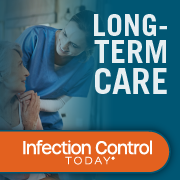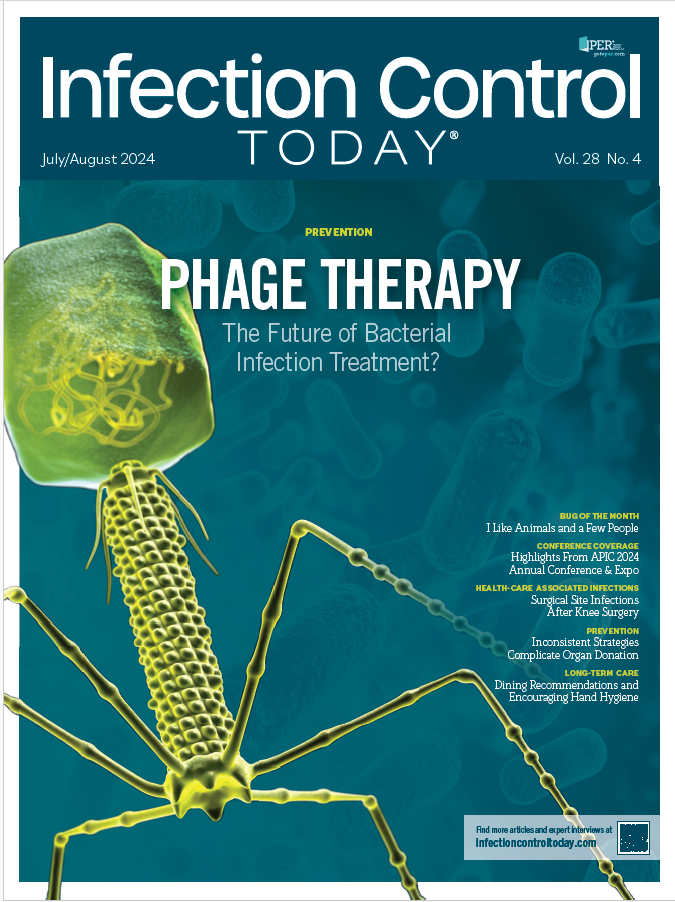Communal dining offers a wealth of benefits for residents in long-term care (LTC) facilities, including enhanced social interaction, improved nutrition, and a greater sense of community and belonging.1 Sharing meals can combat feelings of
loneliness and depression, which are common among older adults, while also encouraging better eating habits and nutritional intake.2
However, it is crucial to acknowledge that residents in LTC are at an increased risk of infection due to factors such as their advanced age, underlying health conditions, and compromised immune systems. While dining, residents in LTC facilities are susceptible to various infections due to close contact with other people and shared surfaces. Gastrointestinal infections such as norovirus and Clostridioides difficile can spread through contaminated food, utensils, and surfaces, leading to symptoms like diarrhea and vomiting. Respiratory infections, including influenza and respiratory syncytial virus, can be transmitted through droplets when residents are in close proximity, especially if coughing or sneezing occurs. Additionally, foodborne pathogens like salmonella and Escherichia coli pose a risk if food is not handled and prepared safely. Therefore, while fostering the positive aspects of communal dining, it is imperative to implement infection prevention measures to ensure the health and safety of all residents.
During the COVID-19 pandemic, dining recommendations for LTC facilities underwent significant changes based on guidelines from the Centers for Medicare & Medicaid Services.3 Communal dining was often restricted or modified to maintain social distancing, with meals served in individual rooms or at staggered times to minimize contact. Enhanced cleaning protocols, the use of personal protective equipment (PPE) by staff, and rigorous health screenings became standard practices to prevent COVID-19 outbreaks.
Now that the pandemic is over, infection preventionists (IPs) have a valuable opportunity to integrate the lessons learned from these measures into everyday practice. By continuing to emphasize hygiene protocols and health monitoring, IPs can provide robust guidance that ensures the safety and well-being of residents while allowing them to enjoy the benefits of communal dining.
Predining Guidance
Before meals start in LTC facilities, it is essential to follow specific guidance to ensure infection prevention and maintain resident safety. Here are some key recommendations:
Hand hygiene: Ensure that both residents and staff wash their hands thoroughly with soap and water or use hand sanitizer before meals. Hand hygiene stations should be easily accessible in the dining area. Many LTC facilities use hand sanitizing wipes because patients in wheelchairs often cannot access the sink to adequately scrub off germs. Also, hand hygiene reminders should be displayed in these areas.
Health screenings: Conduct health screenings for all residents and staff before entering the dining area. This includes checking for symptoms of illness such as fever, cough, or any other signs of infection. If a resident has an easily transmissible infection, such as a respiratory virus, it is recommended that a person eat separately from the other residents. For a resident with a respiratory virus, consider recommending that they eat in their room, outside on the patio, or in the dining area after asymptomatic residents have left.
Sanitization of dining area: Clean and disinfect all surfaces in the dining area, including tables, chairs, and high-touch areas like door handles and light switches. Use Environmental Protection Agency (EPA)-approved disinfectants that are effective against viruses and bacteria.
Seating arrangements during outbreaks: It is also critical to conduct a risk assessment and develop guidance regarding communal dining during outbreaks4 or periods of significant disease transmission, such as the influenza season. Arrange seating to maintain appropriate physical distancing during these times. Ensure that tables are spaced out and limit the number of residents per table, if necessary.
Meals given consecutively: Without the fear of a pandemic, It is essential that all residents receive their meals at the same time and not feel hurried by staff members clearing the plates of those who finish before others.5
PPE for staff: PPE is not necessary per CDC and World Health Organization guidelines.6,7 These guidelines say that individuals should decontaminate their hands after contact with inanimate objects in the immediate vicinity of an infected patient. However, gloves and gowns are not necessary for food service, just proper hand hygiene.
Premeal communication: Clearly communicate any new or temporary dining protocols to residents and staff. This can include changes in seating arrangements, meal service procedures, or any additional precautions being taken.
Respiratory etiquette: Remind residents to cover their mouths and noses with a tissue or arm when coughing or sneezing and to wash and sanitize their hands immediately afterward.
Individualized meal preparations: Consider individualized meal setups to minimize shared items. This can include individual condiments, utensils, and preplated meals to reduce the risk of cross-contamination.
Encouraging Hand Hygiene
Encourage residents and staff to wash their hands thoroughly with soap and water or use hand sanitizer after the meal. Hand hygiene stations should be conveniently located near dining areas. To encourage hand hygiene among residents before and after mealtimes, it is important to use a combination of education, accessibility, and positive reinforcement.
Firstly, begin by educating residents about the importance of hand hygiene in preventing infections and promoting overall health. This can be done through engaging presentations, informative posters, and reminders during daily routines. Ensure that hand hygiene resources, such as sinks with soap or hand sanitizer dispensers, are easily accessible near dining areas. All residents can also be given a pocket-size hand sanitizer to keep with them to use at any time.
Staff should lead by example, consistently practicing and demonstrating proper hand hygiene techniques. Staff can also organize interactive activities such as hand hygiene workshops where residents can learn through hands-on demonstrations and games. Use UV light and special lotion to show the presence of germs and how proper washing removes them. Other fun activities such as themed days with hand hygiene-focused games and prizes, incentive programs with prizes and rewards, and hand hygiene music and rhymes can be creative methods to promote hand hygiene. (Annually, May 5 is World Hand Hygiene Day and is a great opportunity to host events for LTC residents and visitors.)
LTC residents enjoy participating and engaging in their residential community. A hand hygiene ambassador program or committee can be formed to appoint hand hygiene champions to lead by example and encourage their fellow residents to follow good practices.
Additionally, create a supportive environment by offering gentle reminders and assistance as needed, and recognize and praise residents who regularly practice good hand hygiene. Staff should also include residents’ family members and other visitors to encourage and model behavior for hand hygiene.
Postdining Guidance
After dining, LTC facilities should follow the following guidelines:
- Thorough cleaning and disinfection: Clean and disinfect all dining surfaces, including tables, chairs, trays, and high-touch areas, such as doorknobs and light switches, immediately after meals. Use EPA-approved disinfectants that are effective against viruses and bacteria.
- Use of PPE: PPE is used to prevent exposure to blood and body fluids and is not generally used in dining settings. LTC guidance frowns on it, citing it as a dignity issue.
- Laundry management: Collect and launder any reusable dining items, such as tablecloths, napkins, and chair covers, following proper infection control guidelines. Use hot water and the appropriate detergents to ensure thorough cleaning at a temperature of at least 160 °F for a minimum of 25 minutes.8
- Waste management: Dispose of food waste and disposable dining items in a sanitary manner. Ensure that waste bins are emptied regularly and cleaned to prevent the buildup of bacteria and odors. LTC guidance frowns on single-use utensils like plastic forks and plates because of dignity issues, so those are not often used.
- Air circulation: Improve ventilation in the dining area to reduce the concentration of airborne pathogens. Ensure that heating, ventilation, and air-conditioning systems are maintained, and filters are changed regularly.
- Monitor for symptoms: Continue to monitor residents and staff for any symptoms of illness, such as fever, cough, or gastrointestinal issues, after meals. Promptly isolate and assess any individuals displaying symptoms to prevent potential outbreaks.
- Staff training: Provide ongoing training for staff on proper cleaning protocols, use of PPE, and infection control practices. Regularly update training to reflect the latest guidelines and best practices.
- Documentation: Keep detailed records of cleaning and disinfection activities, health screenings, and any incidents of illness. This documentation helps in tracking patterns and making informed decisions about infection prevention measures.
- Feedback mechanism: Establish a system for residents and staff to provide feedback on dining protocols and infection prevention practices. Use this feedback to make continuous improvements and address any concerns promptly.
- Ensuring proper dining practices in LTC facilities is paramount for protecting the health and well-being of residents. By implementing infection prevention measures before, during, and after meals, facilities can significantly reduce the risk of infections. This not only safeguards these vulnerable populations but also enhances their quality of life by allowing them to enjoy the social and nutritional benefits of communal dining.
References
- Why eating together is better for seniors. Elder Care Alliance. October 23, 2022. Accessed June 25, 2024. https://eldercarealliance.org/blog/eating-togethe/
- The social nourishment: exploring the benefits of congregate dining in assisted living. Elder Care Alliance. November 2, 2023. Accessed June 25, 2024. https://www.springarborliving.com/blog/2023/11/02/the-social-nourishment-exploring-the-benefits-of-congregate-dining-in-assisted-living/
- Physicians and other clinicians: CMS flexibilities to fight COVID-19. Centers for Medicare & Medicaid Services. November 6, 2023. Accessed on June 25, 2024. https://www.cms.gov/files/document/physicians-and-other-clinicians-cms-flexibilities-fight-covid-19.pdf
- Communal dining guidance. American Health Care Association and National Center for Assisted Living. October 20, 2022. Accessed June 25, 2024. https://www.ahcancal.org/Survey-Regulatory-Legal/Emergency-Preparedness/Documents/COVID19/Communal-Dining-Approaches.pdf
- Dignity in the dining room. CMS Compliance Group Inc. May 10, 2012. Accessed June 25, 2024. https://cmscompliancegroup.com/cmscg-updates/10-qis-dining-observation-tips/
- Personal protective equipment (PPE): protect the worker with PPE. Health products policy and standards. National Institute for Occupational Safety and Health. CDC. October 3, 2022. Accessed June 25, 2024. https://www.cdc.gov/niosh/learning/safetyculturehc/module-3/7.html
- Personal protective equipment (PPE). World Health Organization. Accessed June 25, 2024. https://www.who.int/teams/health-product-policy-and-standards/assistive-and-medical-technology/medical-devices/ppe
- Guidelines for environmental infection control in health-care facilities (2003): section G. laundry and bedding. CDC.January 8, 2024.Accessed June 25, 2024. https://www.cdc.gov/infection-control/hcp/environmental-control/laundry-bedding.html


